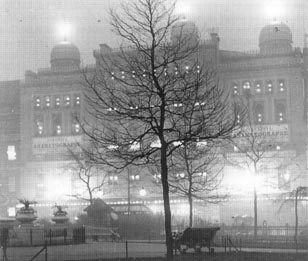
THE LONDON PROJECT:
The Early Film Business in London, 1894-1914
Birkbeck, University of London
The
Mayor of London’s Office has recently published an inquiry into cinema
provision in the capital, showing how uneven this is across the boroughs.
Now the Centre’s London project will show for the first time in detail
how the moving picture industry emerged during its first twenty years,
within the area which saw its most explosive development. An important
feature of our study will be the correlation of knowledge about exhibition
as well as production, and the emergence during this period of distribution
as a distinct sector of the trade. By
mapping the growth of this dynamic new industry and entertainment
medium, year by year, it will become possible to trace for the first
time how moving pictures were shaped by the economic and social geography
of the capital – and how they in turn helped shape the ‘imperial metropolis’
of Edwardian London. Such a realization has been largely missing from
the accounts of London’s historians, beyond a token acknowledgment
of the spread of ‘super cinemas’. But film was already an important
business, transforming lives and fortunes for a decade before these
appeared. It
has also been missing in any systematic form from the work of British
film historians, ever since Rachael Low drew attention to the wide
disparity of contemporary estimates of the number of cinemas as long
ago as 1948. Most studies since have concentrated instead on the work
of individual producers, or on pervasive aspects of exhibition such
as the shift from music halls and ‘penny gaffs’ to purpose-built cinema
halls. As a result, we have only an impressionistic view of how
production and exhibition actually developed during the period up
to 1914 – a period that was crucial in witnessing Britain’s early
lead in both production and exhibition decline, to the point where
foreign suppliers were the majority suppliers to a burgeoning exhibition
sector by 1914. The
study’s methodology will involve collation and evaluation of existing
published materials, including the early film trade press, and major
works of synthesis such as Low, Sadoul and Barnes, as well as sampling
of contemporary newspaper and ephemera sources. A second phase will
be the study in depth of selected areas of London, using local history
archives, to determine through ‘micro studies’ the pattern production
and exhibition development, together with associated factors such
as transport and housing density. Where were cinemas created? And
how did audiences reach them? Why did studios move and how did they
develop, as production became more elaborate. We
plan to present the result of the study in detailed database form,
but also visually and accessibly, enabling trends to be seen, year
by year, and compared. There will be issues of coverage and of what
attention should be paid to the parallel development of other forms
of mechanised or ‘mass’ entertainment, such as music hall, theatre,
dance halls, etc. A series of seminars will convened during late 2004
to canvass expert opinion on these matters; and also to identify likely
members of our Advisory Panel. Publication
and dissemination of the study will be as important as the data collection
and analysis, since it will inform the work of economic and social
historians for beyond the field of Film Studies, and may well be of
interest to practitioners working with archives, local museums, ‘knowledge
centres’, and in strategic planning. We plan to mount a public exhibition
based on the study, as well as on-line access to its findings and
other forms of publication. Early
central London exhibition venues: Top:
The Alhambra Music Hall, Leicester Square (site of the present Odeon),
where Robert Paul exhibited his 'Animatographe' from 1896-7. Below:
The Egyptian Hall, Picadilly, in 1902 Both
photos reproduced from John Barnes, The Beginnings of the Cinema
in England, 1894-1987 Dr
Luke McKernan Simon
Brown Jonathan
Davis


Research team:
Professor Ian Christie
Project Director
Senior Research Fellow
Senior Research Fellow
Research Advisor
Contact:
Professor Ian Christie
AHRB Centre for British Film and Television Studies
Birkbeck
Room 102
43 Gordon Square
London WC1H 0PD
020 7631 6196
i.christie@bbk.ac.uk